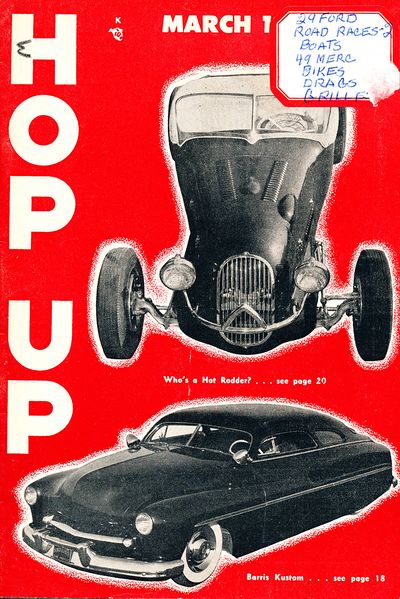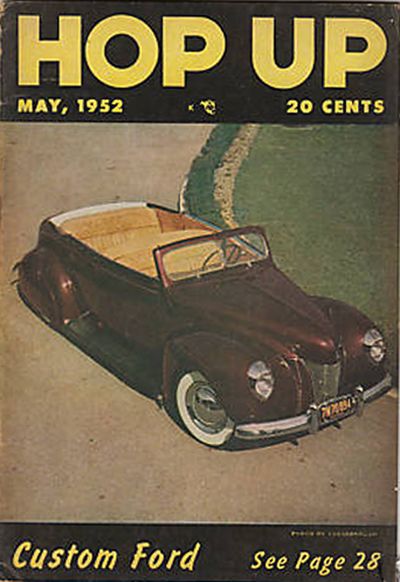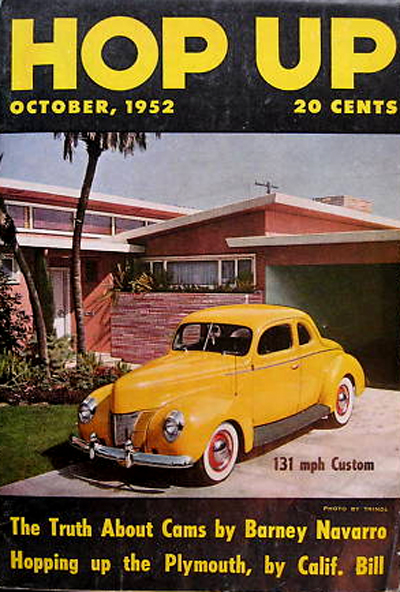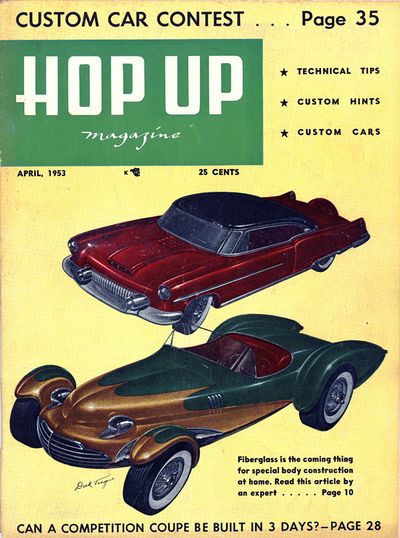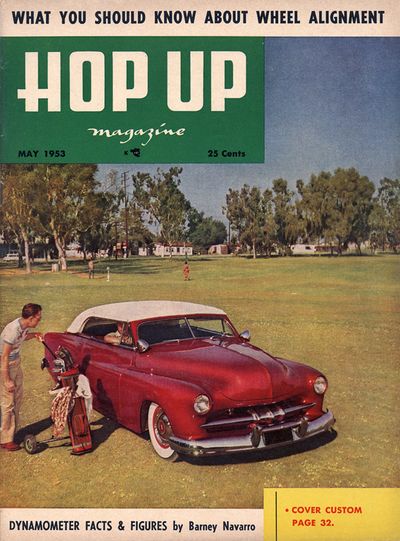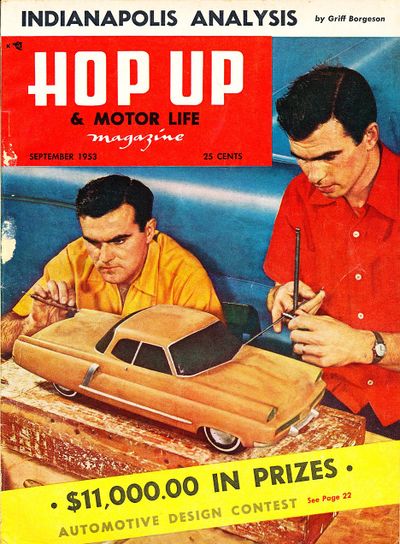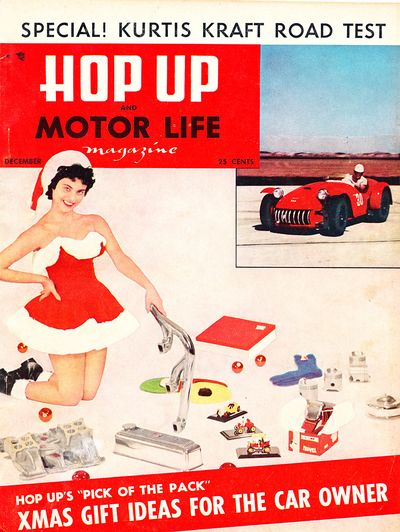Hop Up
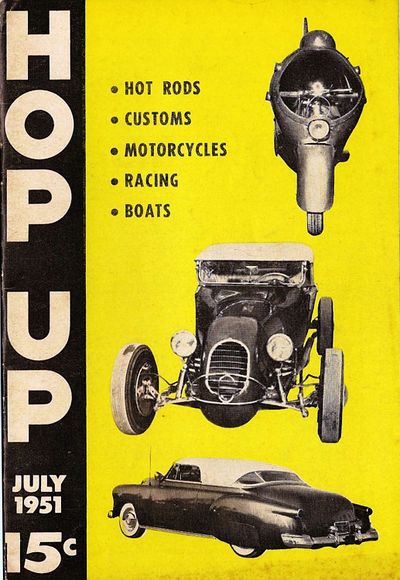
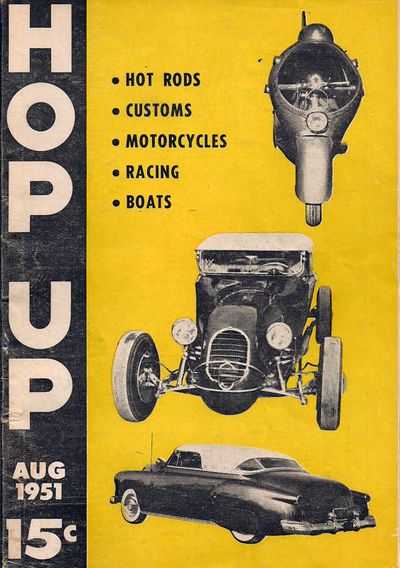
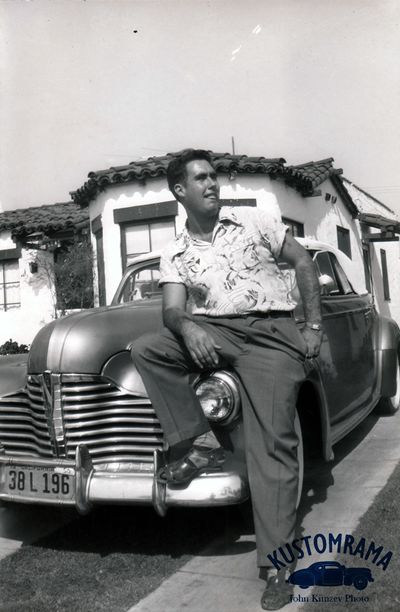
Hop Up Magazine was born in the offices of Road & Track by Enthusiast's Publications at 540 W. Colorado Blvd., in Glendale, California. The year was 1951, and as the hot rod and custom movement was growing, some staffers of Road & Track felt it was time to add some stories on local cars and happenings, and not just foreign cars. Publisher Oliver Billingsley agreed, but demanded that they should do it as a separate issue, printed as a half size magazine measuring 5.5 x 8.0 inches. The newly born magazine would only have 48 pages including the cover, and with content prepared by the Road & Track staff in their spare time to eliminate buy-out expenses. By doing this, the only cost involved with the magazine was printing. The expenditure would be offset by ad sales to local speed merchants. The magazine was priced at 15 cents or $1.50 per year.[1] With its July 1951 issue, Hop Up Magazine pioneered the "little pages" magazine concept. The July printing was small for a newsstand test to judge if such an ankward-size magazine would sell. It did, and the cover date was changed to August, before alterations were made inside and a full-tilt printing was ordered. Vol. 1, No. 1 was printed on both issues.[1]
By 1952 the magazine was maturing. Dean Batchelor joined the Hop Up staff in April 1952[2], and due to Dean's insistence on quality and accuracy, the quality on the stories improved. During the year, the articles on boats and motorcycles were dropped in favor for more articles on hot rod and custom cars.[1] Things went along well enough until financial problems loomed in 1952. Bill Quinn, Road & Track ad manager and minor shareholder feared the worst, so he traded his shares in the company for the rights to Hop Up. Bill moved the magazine and the newly born Quinn Publications to the building next door, taking with him artist/writer Lou Kimzey, photographer Ralph Poole, and Dean Batchelor. The new office was a small bungalow with a living room, two bedrooms, one bath, and a kitchen that was converted in to a darkroom. Hop Up's first Quinn issue hit the newsstand July 1952.[2]
In February 1952, Dean Batchelor saw Spencer Murray's 1949 Chevrolet Custom at the 3rd annual Oakland Roadster Show. Dean liked it, and had Ralph Poole photograph it for the June 1952 issue. After attending the Oakland Roadster Show Spencer entered his Chevy at the 1952 Indianapolis Custom Auto Show that ran during the week before the 500-mile race. Dean thought the long trip in a taildragging custom would make a cool story, so he sent Ralph with Spence to take photos along the way. The result was published in Hop Up September 1952 under the title "6000 miles in a Custom". Dean had Spence write the story, and it inspired him to ask Spencer if he would consider leaving Link's Custom Shop to work at Hop Up. The choice was easy, and Spence began to work for Hop Up in January 1953. When Spence started, he was paid $35.00 a week. Work started at 8:30 and went to 5:00. There were no expense accounts, no mileage allowance, and no company car. To cover a car show or the drags the crew was on their own. When Quinn was away he would lock the phones so the staff couldn't run up the bill chatting with friends. Spence's job was to write photo captions, and help the secretary Mabel typing labels for subscriber copies.[2]
Contents
Size Matters
By 1953 growth was necessary for the magazine in order to survive. Hop Up turned out to be only marginally successful financially. Due to its small size, newsstands were reluctant to stock a magazine whose size made it hard to display and easy to pilfer. Big advertisers had also little interest in low-circulation, localized magazines, so by February 1953 the small size was sacrificed, and the first full-sized issue of Hop Up hit the newsstand March 1953. The new size mandated a price increase from 15 to 25 cents. The new magazine generated a ton of mail from dedicated readers demanding the staff to bring back the little "Hop Up" which easily fit into a pants' pocket, glovebox, or textbook. As it would have been physically impossible to resurrect the small size, it was decided to create a new small size magazine instead. The new magazine, called Rods and Customs, made its debut in May 1953. In order to avoid hiring new people, Bill Quinn assigned the new magazine to Spencer Murray, without lessening his Hop Up duties.[1] Spence got the editor job because evryone else was busy with the new Hop Up. The first few issues of Rod & Custom were scraped together with unused Hop Up material, full-page salon photos of cars featured in earlier issues, and a few pinup girls for good measure. All of the Hop Up staff were working on both magazines, and Barney Navarro become their tech guy swapping his input for ad space. Spence kept writing Hop Up captions and typing labels while being the editor of Rod & Custom. The guys at Petersen Publishing had heard rumors about the new magazine, and answered by publishing their own small-size magazine Honk! in May 1953. Rod & Custom beat Honk! to the newsstand by a week. Quinn was jealous of Petersen's adress at 5959 Hollywood Blvd. He felt that address gave a magazine much more prestige than an address in a Glendale suburb, so he found an office space at 4949 Hollywood Blvd that Quinn Publications moved into. With the new address, Quinn hoped he would get wayward Petersen mail, but the mailman knew better.[2]
Motor Life Magazine
By 1954 emphasis on Hop Up's title decreased while the tag line Motor Life increased. By February 1954 editor Hill was replaced by Don Werner. By April 1954 Motor Life dominated the cover with the small subtitle "Formerly Hop Up and Motor Life" below it.[1] The name of the magazine was changed in order to give it more dignity against rival Motor Trend.[2]
Motor Trend Magazine
One Friday In 1955 the staff of Quinn Publications said their usual weekend goodbye, when they returned on Monday they were greeted by Robert E. Petersen. Robert had bought Quinn Publications, and Rod & Custom and Motor Life were his property. The first Rod & Custom for Petersen was July 1955, and the staff of old Quinn Publications moved into 5959 Hollywood Blvd. After the move, Motor Life later merged with Motor Trend, and any vestiges of Hop Up were gone.[2]
Employes
William Quinn Advertising Manager
Bob Canaan - Photographer
Dean Batchelor
Don Werner
Gene Trindl - Photographer
Jack Caldwell - Art
Jack Campbell - Photographer
Jerry Chesebrough - Staff Photographer
Joe Al Denker - Photographer
John R. Bond - Technical Editor
Ken Fuhrman - Photographer
Louis Kimzey - Art Director
Oliver Billingsley - Publisher / Editor
Ralph Poole
Robert Dearborn - Associate Editor
Robert Johnson
Spencer Murray
W. Everett Miller - Historical Editor
W. H. Brehaut, Jr. - Managing Editor
Issues of Hop Up
1951
Hop Up July 1951
Hop Up August 1951
Hop Up September 1951
1952
Hop Up March 1952
Hop Up April 1952
Hop Up May 1952
Hop Up October 1952
1953
Hop Up January 1953
Hop Up February 1953
Hop Up April 1953
Hop Up May 1953
Hop Up July 1953
Hop Up & Motor Life Magazine September 1953
Hop Up And Motor Life Magazine November 1953
Hop Up And Motor Life Magazine December 1953
References
Did you enjoy this article?
Kustomrama is an encyclopedia dedicated to preserve, share and protect traditional hot rod and custom car history from all over the world.
- Help us keep history alive. For as little as 2.99 USD a month you can become a monthly supporter. Click here to learn more.
- Subscribe to our free newsletter and receive regular updates and stories from Kustomrama.
- Do you know someone who would enjoy this article? Click here to forward it.
Can you help us make this article better?
Please get in touch with us at mail@kustomrama.com if you have additional information or photos to share about Hop Up.
This article was made possible by:
SunTec Auto Glass - Auto Glass Services on Vintage and Classic Cars
Finding a replacement windshield, back or side glass can be a difficult task when restoring your vintage or custom classic car. It doesn't have to be though now with auto glass specialist companies like www.suntecautoglass.com. They can source OEM or OEM-equivalent glass for older makes/models; which will ensure a proper fit every time. Check them out for more details!
Do you want to see your company here? Click here for more info about how you can advertise your business on Kustomrama.
